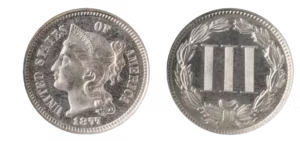Civil War Hoarding Created a Need for the Nickel Three Cent Piece
Posted on — Leave a commentThe Civil War impacted nearly every aspect of Americans’ lives. Amid the military battles, food shortages, and economic chaos, people hoarded any precious metals they could get their hands on. That included the three-cent silver piece, the smallest silver coin produced at that time by the U.S. Mint. This created a currency shortage for daily commerce and trade.
they could get their hands on. That included the three-cent silver piece, the smallest silver coin produced at that time by the U.S. Mint. This created a currency shortage for daily commerce and trade.
In an effort to ease the currency shortage, the U.S. Treasury issued small-denomination paper notes, ranging from three cents up to fifty cents. These paper notes became known as fractional currency. But the public distrusted and disliked paper currency.
A Distrust of Paper Currency Opened the Door to Using Nickel in Coins
In 1865, Congressman John Kasson, widely known for being against using nickel in coins, sponsored a bill to authorize a new three-cent coin made of nickel and copper. The reason Kasson changed his mind? He liked fractional currency even less than he liked nickel coins. The bill passed, and a new three-cent nickel coin was born.
The Philadelphia Mint struck nickel three-cent coins from 1865 through 1889. The public instantly embraced them, finding nickel three-cent pieces extremely convenient because they could be used to buy postage stamps, which cost three cents at the time.
1877 Nickel Three Cent Piece: A Key Date with a Tiny Proof Only Mintage
Collectors typically acquire the nickel three-cent piece as a type coin. However, within the series, there is a prominent and highly desirable proof-only mintage. In 1877, the Philadelphia Mint produced 900 proofs of the nickel three-cent piece, the lowest number of the entire series. Survivors are scarce.
Today, only 350 of the 1877 key date three-cent nickels are shown in grades 65 or better. See a prized 1877 Nickel three-piece coin here.
Coin Design
The original design adopted in 1865 remained unchanged for the 24 years the coin was produced. Chief Engraver James Longacre created the crisp and clean design. The obverse featured the head of Liberty facing left. She wears a beaded coronet carrying the word: LIBERTY. The date and UNITED STATES OF AMERICA encircle the obverse. The reverse is an impactful and simple design highlighting the Roman numeral III in the center, surrounded by a delicate wreath.








